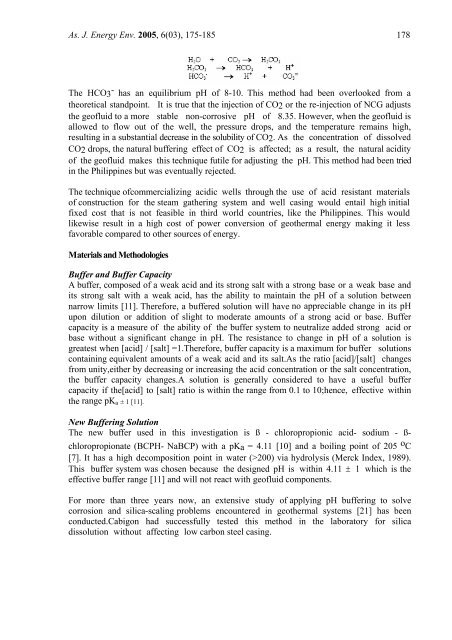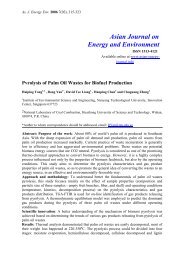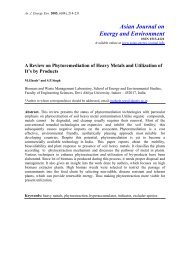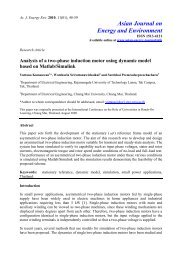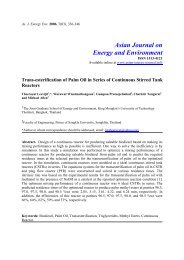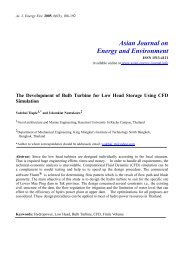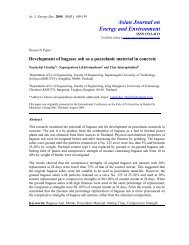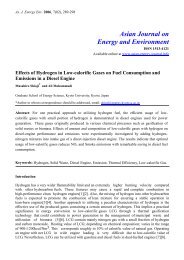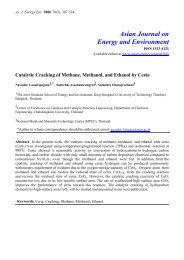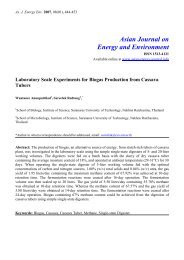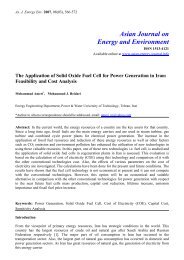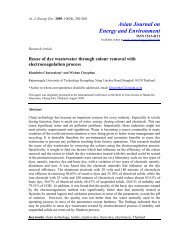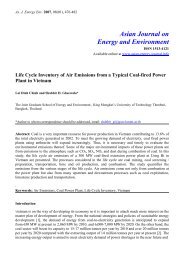Commercialisation of acidic geothermal wells by ph buffering
Commercialisation of acidic geothermal wells by ph buffering
Commercialisation of acidic geothermal wells by ph buffering
Create successful ePaper yourself
Turn your PDF publications into a flip-book with our unique Google optimized e-Paper software.
As. J. Energy Env. 2005, 6(03), 175-185 178The HCO3 - has an equilibrium pH <strong>of</strong> 8-10. This method had been overlooked from atheoretical standpoint. It is true that the injection <strong>of</strong> CO2 or the re-injection <strong>of</strong> NCG adjuststhe ge<strong>of</strong>luid to a more stable non-corrosive pH <strong>of</strong> 8.35. However, when the ge<strong>of</strong>luid isallowed to flow out <strong>of</strong> the well, the pressure drops, and the temperature remains high,resulting in a substantial decrease in the solubility <strong>of</strong> CO2. As the concentration <strong>of</strong> dissolvedCO2 drops, the natural <strong>buffering</strong> effect <strong>of</strong> CO2 is affected; as a result, the natural acidity<strong>of</strong> the ge<strong>of</strong>luid makes this technique futile for adjusting the pH. This method had been triedin the Philippines but was eventually rejected.The technique <strong>of</strong>commercializing <strong>acidic</strong> <strong>wells</strong> through the use <strong>of</strong> acid resistant materials<strong>of</strong> construction for the steam gathering system and well casing would entail high initialfixed cost that is not feasible in third world countries, like the Philippines. This wouldlikewise result in a high cost <strong>of</strong> power conversion <strong>of</strong> <strong>geothermal</strong> energy making it lessfavorable compared to other sources <strong>of</strong> energy.Materials and MethodologiesBuffer and Buffer CapacityA buffer, composed <strong>of</strong> a weak acid and its strong salt with a strong base or a weak base andits strong salt with a weak acid, has the ability to maintain the pH <strong>of</strong> a solution betweennarrow limits [11]. Therefore, a buffered solution will have no appreciable change in its pHupon dilution or addition <strong>of</strong> slight to moderate amounts <strong>of</strong> a strong acid or base. Buffercapacity is a measure <strong>of</strong> the ability <strong>of</strong> the buffer system to neutralize added strong acid orbase without a significant change in pH. The resistance to change in pH <strong>of</strong> a solution isgreatest when [acid] / [salt] =1.Therefore, buffer capacity is a maximum for buffer solutionscontaining equivalent amounts <strong>of</strong> a weak acid and its salt.As the ratio [acid]/[salt] changesfrom unity,either <strong>by</strong> decreasing or increasing the acid concentration or the salt concentration,the buffer capacity changes.A solution is generally considered to have a useful buffercapacity if the[acid] to [salt] ratio is within the range from 0.1 to 10;hence, effective withinthe range pK a ± 1 [11].New Buffering SolutionThe new buffer used in this investigation is ß - chloropropionic acid- sodium - ß-chloropropionate (BCPH- NaBCP) with a pKa = 4.11 [10] and a boiling point <strong>of</strong> 205 o C[7]. It has a high decomposition point in water (>200) via hydrolysis (Merck Index, 1989).This buffer system was chosen because the designed pH is within 4.11 ± 1 which is theeffective buffer range [11] and will not react with ge<strong>of</strong>luid components.For more than three years now, an extensive study <strong>of</strong> applying pH <strong>buffering</strong> to solvecorrosion and silica-scaling problems encountered in <strong>geothermal</strong> systems [21] has beenconducted.Cabigon had successfully tested this method in the laboratory for silicadissolution without affecting low carbon steel casing.


